The Efficiency and Competitiveness of Low-Orbit Satellite CommunicationsSystems Based on the Small Spacecraft

Dr.Sc., Deputy General Director VSAT-TEL
Presented parameters determining the efficiency of communication systems on the basis of low-orbit satellites. A simple rapid method of comparing their performance with each ofither and competing satellite systems such as HTS. Evaluating the effectiveness and competitiveness based on a comparison of the cost for transmission a unit information. It is shown that this option is significantly improved over the last twenty years to LEO-HTS. For example, projected today LEO systems such as LEO-HTS, in some cases by an order have higher efficiency than the previous generation of such systems in the 2000s.Their efficiency is comparable with satellites HTS 3rd generation (such as Viasat-2), but not higher than the efficiency of satellite systems HTS, planned for 2020.However, analysis of the problems of realization of future systems LEO-HTS, shows that as of the next few years is no technical solutions to create cheap antennas for subscriber terminals. In the past, this fact fundamentally affect the realization of projects of low-orbit systems (Teledesic, SkyBridge), so there is no reason to place special hopes on the rapid development of low-orbit communications systems.
In Russia particular attention to small satellites it began in the late 80-s and early 90-s. First of all attention was due to the fact that the opportunity to launch small satellites using a converted ballistic missile, which under an agreement with the US should be withdrawn from combat duty. It was assumed that we can very quickly and with minimal financial investment to adapt military rockets to launch commercial satellites and reduce the cost of start-up to a minimum. But the reality was much more complex and longer over time (as of 2015 only one type of a series of ballistic missile SS-18 has been modified for commercial use and was called Rockot).
However, the idea of a small satellite (both geostationary and non-geostationary even more) began to live your life. Today, the idea took shape as a recognized trend in the global space industry.
Classification of small satellites is conditional. Table 1 shows data taken from different sources. The basis of the classification adopted by NASA.
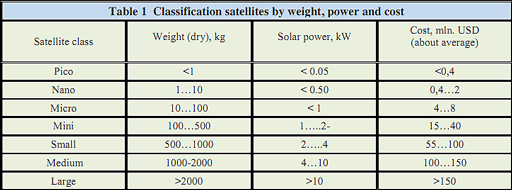
This review discusses some of the issues of small satellites (from 10 kg to 1,000 kg inclusive) for the purpose of communication.
Today, a significant stimulus for the development of systems based on the small satellite is the projected decrease the cost of 1 kg launch into low orbit (Fig.1).
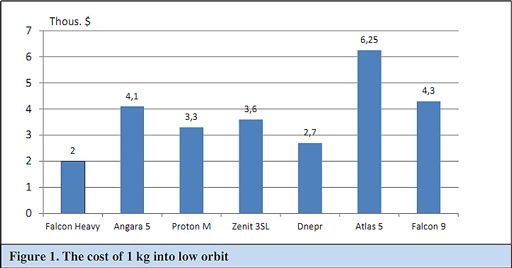
Nano and Micro Satellites
Nano satellites (1-10 kg) and micro satellites (11-100kg, a number of publications 11-50 kg) used to solve various problems, but these problems cannot be called today commercially oriented. The only direction in which to some extent is a commercial perspective are issues of telecommunication. These problems mainly relate to the organization of multi-satellite system to transmit data type "email". Displacement industry in this area is a small fraction (marked with red in Fig. 2) from the total market value related to nano and micro satellites. The cost of creating the satellites within 0.3-2 million $. Production time does not exceed 1-1.5 years (respectively correctness of the long-term prognosis is very low). According SpaceWorks number of satellites that run during 2010-2013. It ranged from 21 to 36 satellites per year. In the period before 2020. the annual launch of the nano and micro reaches 121-188. However, the satellites are focused on the problem of telecommunications, will make a relatively small proportion, about 6% (excluding military satellites, for example, TacSat, SMDS-ONE). The main task to be solved with the use of nano and micro - collecting data from moving and stationary objects, i.e. the solution of problems within the M2M market. But in the long term can be extended functions in connection with the development of general philosophical trend IoT.
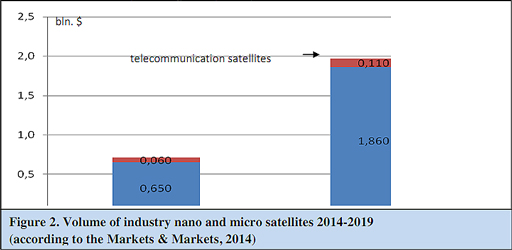
The founder of the direction of the nano and micro is Surrey Satellite Technology Ltd. (SSTL). Start of development of this area belongs to 2000. As of 2014 manufacture of satellites takes a lot of companies. It should be emphasized Clyde Space Limited (http://www.clyde-space.com/). The general direction for nano and micro today:
Services provided using nano and micro, the most actively will be used in the Asia-Pacific region and in North America to meet the challenges of automatic identification of objects (Automatic Identification System, AIS).
The satellites are displayed on the low orbits, the service life of satellites is limited, but there is evidence that lifetime can reach 5-7 years. However, in general lifetime not exceeding 2 years. Projections of microsatellites industry are mainly related to remote sensing tasks.
In Russia, the creation of such satellites has been a private company, "Dauria Aerospace" which 2013-2014 launched satellites Perseus-M and DX1, designed for tasks AIS. Financing of the works carried out Roskosmos and private funds of the owner of the company.
Data on the commercial part of the project yet, although a number of government organizations have expressed their interest. The main industry development of nano and micro satellites to be associated with non-profit objectives in the field of science and military missions on the ground and in space.
Mini and Small satellites
Non-geostationary satellites weighing from 100 kg to 1000 kg, and is widely used for a relatively long communication purposes. The first commercial system based on such satellites Iridium and Globalstar. The development of these systems relates to the beginning of the 90s. s. In those years there was the euphoria associated with the establishment of LEO systems for personal communications. It was assumed that the number of subscribers such satellite systems is in the tens of millions in the next 5-7 years. Only in Russia is developing at least 10 projects (to date in Russia continues work funded from the budget of the Federal Space Agency to establish a messenger system, which provides data transmission, but the result is not commercial in 2015.).
However, it became clear fairly quickly that the low-orbit communications systems are not commercial efficiency. And there was a significant increase in additional investments in the process of deploying multi-satellite space segment groups and the creation of a network of gateway earth stations (Figure 3). The vast majority of projects had been closed by the early 2000. Figure 3 shows the initial values in 1992 correspond to the declared cost of the project. In 2002 published data on the total costs, which have been produced to ensure normal operation of the system, i.e. the actual costs. Data Figure 3 can be used to assess the risk factor, which shows an increase in the cost of the project low-orbit communications system from its beginning to the practical standard operating system. Based on the data in Fig. 3, risk factor Kr = 1.78 ... .3.17 (an average rounded value Kr = 2.5).
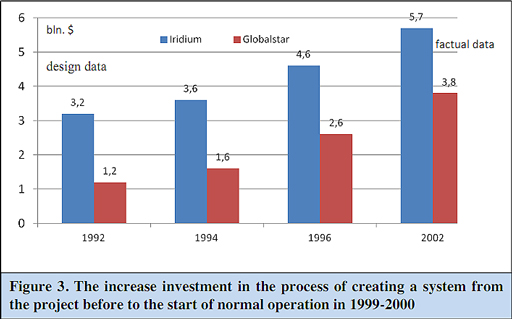
In early 2000, after the obvious economic failure LEO systems of personal communication and data transmission, it formulated the idea of a low-orbit systems with very high bandwidth. The idea was triggered by the explosive growth of Internet traffic and number of users of the Internet. During these years, many companies developed many such projects. In most of them as the space segment multisatellite proposed to use a constellation of small satellites. The most notable of these projects of Teledesic and Skybridge. These projects have already suggested the use of a range of Ku/Ka and even the Q/V. Going into these ranges was linked to the need to ensure the speed of satellite channels on the Internet, at speeds comparable terrestrial channels. However, in this case, quite quickly it became apparent that to achieve the claimed speeds of channels is problematic, but the main - ground terminal price was so high that it negates all the advantages of the system. As a result, none of the announced projects have not reached the stage of practical realization (up what has been achieved - launched two experimental satellites Teledesic).
Around 2013-2014, there is information about the beginning of the implementation of new multi satellite systems in Ku and Ka-band. Most active began to move in terms of attracting investment system OneWeb and SpaceX (conditional name). The main argument of the developers of these systems in the justification of their relevance: The need for satellite links with low latency signals to create cellular networks 3G/4G in regions remote from the fiber-optic and fiber-optic redundancy. Technical argumentation to justify their economic efficiency is mainly based on two assumptions:
- The mass of the satellites today, compared with the systems of the 2000 reduced by 2-3 times, and their approach to serial production, i.e. cost deployment space constellation can be minimized;
- In terrestrial stations can be used relatively inexpensive antenna systems such as digital active phased arrays created on the basis of a metamaterial.
Together, representatives of companies developing systems LEO-HTS claimed that multisatellite LEO systems have little or no competition from satellite systems, so success is guaranteed in the long term.
Efficiency and competitiveness
For an objective comparison of the effectiveness for different systems will take the value of the unit cost of transmitting information. As such a unit will take Mbps. This unit it is advisable to refer to the month, which gives an idea of the border (excluding OPEX) maximum minimum wage scale in the course of normal operation. As a result, the efficiency is expressed by the simple equation
E = C/(Ri*N*Tlife), (1)
C - declared value system (CAPEX) with the creation of the earth segment, $;
Ri - capacity satellite (direct + reverse channels) Mbps
N - the number of active satellites in the constellation,
Tlife - littered with months of satellite lifetime .
For the projected future systems formula (1) should be clarified by the introduction of a risk factor Kr
E = (C*Kr)/(Ri*N*Tlife) (2)
Table 2 summarizes all the information to evaluate the effectiveness of the system in accordance with formulas (1) and (2). It is obvious that the claimed system today OneWeb, SpaceX much more effective the previous generation of such systems.
To assess their competitiveness (in comparison with other satellite systems) similar data are presented in table 3 for existing and planned systems based HTS. For systems designed HTS risk ratio can take 1 as the price of ground equipment base stations tend to decrease (in the next 3-4 years, a decline of 15% minimum).Comparison of the data in Table. 2 and 3 shows that the projected system OneWeb and SpaceX, relating to the type LEO-HTS, almost identical in technical and economic efficiency (taking into account the projected CAPEX) systems HTS.
However, it should take into account the importance of OPEX systems. Unfortunately, reliable values for OPEX systems LEO-HTS and HTS was not available. But we can assume that OPEX systems LEO-HTS will always be higher. This is due to the need to manage multi-satellite constellation LEO-HTS. Additionally, must consider issues related to the implementation of systems (Tabl.4).

Phased array antennas for subscriber stations
As one of the arguments to justify the effectiveness of LEO-HTS claimed that the cost of the subscriber terminal will be increased to 100-300 $ (SpaceX), 200 $ (OneWeb), ie identical to the cost of the subscriber terminal in a HTS system. And as the antenna system is supposed to use active digital phased array. These antennas are plans to apply and for systems HTS (known application Intelsat, Inmarsat).
In certain projects, special hopes on the company Kymeta and Phasor. Moreover, according to the company Kymeta digital phased array it will be implemented based on metamaterial. Company Phasor such statements were not published.
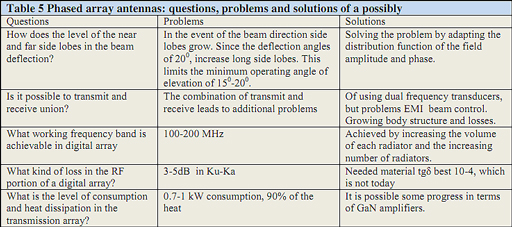
In order to assess the reality of achieving high technical and economic indicators digital phased array for problems of satellite communications in Ku/Ka-band should be on a number of issues, some of which are stated in Table. It should further be noted that the term metamaterial introduced as a promotional travel. Such materials are known from the 50's, formerly known as artificial dielectric. Today it is a material based on artificial dielectric with electrically controlled environment.
Special danger of the use of phased array antennas as a ground terminal for operation in LEO-HTS interfaced with the need to respect the conditions of electromagnetic compatibility with the systems implemented on geostationary satellites. A similar problem exists for the use of phased array antennas on moving vehicles when working with satellites HTS.
Summary
Comparison known today parameters of future systems LEO-HTS with the parameters of modern systems HTS shows that the effectiveness of LEO-HTS excluding the costs of their operation is slightly better. Compare LEO-HTS with projected HTS systems shows that their effectiveness can be considered approximately identical.
However, a common problem LEO-HTS systems to minimize the cost of the ground segment of the subscriber is still not solved.
Literature:
- Анпилогов В.Р., Малые спутники на ГСО. Обзор и анализ российских проектов, Технологии и средства связи, №6, 2000г.
- Ефремов А. Г. Витер В. В. и др. Малые спутники в сетях связи ивещания//Технологии и средства связи. 2000.№ 1
- Прохоров Ю.В., Петухов А. П., Киселев В. А., Зарубин В. К. Спутниковая система "Диалог" на базе малых космических геостационарных аппаратов: Тезисы доклада. Материалы 4-й Международной конференции "Спутниковая связь-2000". Москва, сентябрь 2000 г.
- Small Spacecraft Technology State of the Art, Mission Design Division Staff Ames Research Center,Moffett Field, NASA/TP–2014–216648/REV1, июль 2014 (https://www.nasa.gov/sites/default/files/files/Small_Spacecraft_Technology_State_of_the_Art_2014.pdf)
- Пусковые услуги, маркетинговые исследования рынка спутниковой связи и вещания 2014/2015, под редакцией Анпилогова В.Р. (доступ http://www.vsat-tel.ru/market/market8.pdf)
- Бородич С.В., О применении систем спутниковой связи со спутниками на низких орбитах, Электросвязь, №9, 1995г., стр.19-24
- Анпилогов В.Р., Эффективность и стоимость универсальных систем подвижной спутниковой связи в "золотых" L и S - диапазонах частот, Технологии и средства связи, №2, 1999г., стр.78-81
- Анпилогов В.Р., Системы персональной спутниковой связи на основе не геостационарных ИСЗ, Век качества, №1, 2001г.,
- Анпилогов В.Р., Еще раз об эффективности спутниковых систем, Век качества, №2, 2005г.
- Крылов А.М., Анализ создания и развития низкоорбитальных систем спутниковой связи, Технологии и средства связи , №6-2, 2010г., специальный выпуск “Спутниковая связь и вещание - 2011”
- Анпилогов В.Р., Сверхинформативные системы спутниковой связи XXI века, Технологии и средства связи, №6, 1998
- Анпилогов В.Р., Система спутниковой связи и передачи данных TELEDESIC - глобальные планы, Broadcasting, №4, 2001г
- Система связи на основе негеостационарных спутников Ка-диапазона, Технологии и средства связи, №6-2, 2009г., специальный выпуск “Спутниковая связь и вещание и вещание-2010”, стр.42-43, обзор под редакцией Анпилогова В.Р. (http://www.vsat-tel.ru/index.php?uid=26&open=1)
- MEO/LEO Constellations: U.S. Laws, Policies, and Regulations on Orbital Debris Mitigation, American Institute of Aeronautics and Astronauticsб 1999, AIAA SP-016-2-1999 (http://www.spacewx.com/Docs/AIAA-730-653.pdf)
- Prokosh B., LEO HTS: The Silver Bullet to Bridge the Digital Divide?, Satellite Executive Briefing, march 2015, p.26-27
- Анпилогов В.Р., Тырин П.М., Эйдус А.Г., Характерные особенности развития спутниковой связи и вещания, - Технологии и средства связи, №6-2, 2014г., специальный выпуск “Спутниковая связь и вещание - 2015” , стр.36-40
- Анпилогов В., О фазированных антенных решетках Ka-диапазона на основе метаматериала // Технологии и средства связи. – 2013. № 5. С. 66–67
- Слюсарь В., Перспективные технологии антенных решеток мобильных терминалов спутниковой связи // Технологии и средства связи. – 2014. № 4. С. 64–68.
Electronic version of articles in the journal “Технологии и средства связи” -
http://www.tssonline.ru/articles2/allpubliks
http://www.tssonline.ru/imag/



